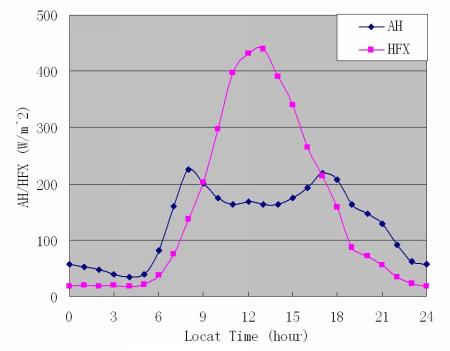(This continues from the previous posting, which compares surface temperatures at two cities to the surrounding areas.)
2. Why are cities warmer than their surroundings?
First, cities have much more concrete,asphalt and other man-made materials. When sunlight hits these surfaces, they absorb energy, heat up and warm the air above them. In contrast, some of the sunlight hitting a field of grass or crops is used to evaporate water from the soil and to draw water from the plants. Thus sidewalks can be too hot to walk barefoot on in the summertime (unless they are wet!) while it’s easy to walk barefoot on the grass.
Second, while buildings provide some shade during the day, they also trap infrared (“heat”) radiation at night. Have you ever used an infrared thermometer? (See GLOBE surface temperature protocol.) Try pointing an infrared thermometer at the side of a building. If you don’t have one, just feel the sides of buildings as you walk by. You will see that the buildings stay warm at night. Buildings radiate heat in all directions – including to buildings across the street, which radiate heat back to them. So the walls of buildings in a city are warmed by surrounding buildings.
You can observe the effect of warming of surfaces by buildings on a frosty night. If you have a car parked in the open but near a building, you will see that the windows facing the building have less frost (or no frost), while the windows on the opposite side have more frost, and the windshield, facing partially upward, probably has the most frost.
Third (and I think this one is the most fun), people are the sources of heat (so-called “anthropogenic heating”. When we use energy, we heat up the environment. For example:
- Heating and air conditioning of our homes release heat to the outside air
- When we use electricity we produce heat
- Burning fuel in cars and trucks releases heat
- Factories and oil refineries release heat
- Businesses release heat
- Our bodies produce heat
Think about the warm smoke coming out of power-plant chimneys, and cooling towers for nuclear power plants. Put your hand on your television or over an incandescent light bulb – it’s warm. Have you ever felt the air coming out of the tailpipe of a car? It’s hot. Once a car operates for awhile, its tailpipe becomes too hot to touch.
How important is anthropogenic heating (or heating due to people’s activities) compared to the effects of concrete and other urban ground cover?
Figure 3 compares the heat supplied to the air by the human activities listed above, for an urban part of Beijing to the heat supplied by the warm surface (concrete, asphalt, buildings, etc.). At noon, the anthropogenic heating in this part of Beijing almost half that due to the surface heating in this part of Beijing. Averaged over the whole day, the anthropogenic heating is over half that due to surface heating. The effect of both types of heating is probably less in other parts of Beijing.
The units are Watts per square meter. This is the same unit used for incandescent light bulbs. If you have an incandescent light bulb (this kind gets warm) nearby, look at the bulb and see how many Watts it radiates.
The “heating” in Figure 3 is “sensible heat” (we can feel it) carried by air currents (convection). The sensible heat transport above a field of green grass at noon in the summertime is of the order of 100 Watts per square meter. The heat transport above a field of harvested crop might be more like 300 Watts per square meter, and the amount of solar energy hitting Earth’s surface on a fair-weather summer day reaches slightly over 1000 Watts per square meter at noon on a clear day. For parts of Tokyo and Houston, the human-generated heat source reaches 1000 Watts per square meter.
Accounting for anthropogenic heat sources and trapping of heat by buildings improved forecasts of minimum temperatures in Phoenix and Philadelphia. In both cases, these effects led to warmer temperatures at night.


A very good question, and it reminds me of childhood. Back then I often wonder why that is so, I have also read and learn a lot and have some time later I found out the answer , but not as full in your article.Tks u!